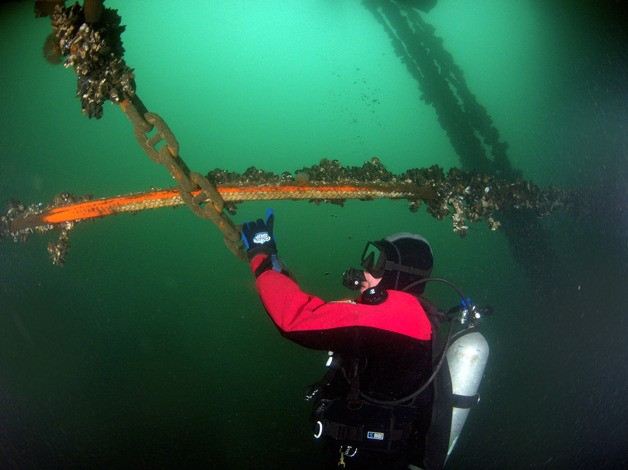Anchor lines securing the new dock at the Langley marina are still crisscrossed and continuing to chafe, and the problem has rubbed the Port of South Whidbey the wrong way long enough.
On Tuesday, the commissioners unanimously agreed at their regular meeting Tuesday to give the district’s attorney the green light to go after the installer, Friday Harbor-based Mike Carlson Enterprises, Inc., for the cost of fixing the lines. Port authorities allege they were hooked up incorrectly when the new floats were installed two years ago.
“We’ve done a long dance with them and they won’t do anything,” Commissioner Curt Gordon said.
Mike Carlson did not return a call for comment left Thursday but the construction firm has in past communications with the port maintained that the work was done as specified and approved.
The $1.7 million project was completed in April, 2014, adding about 330 feet of additional dock space to South Whidbey Harbor. The anchor lines, which help secure the floats to the seafloor, were found by a port-hired diver a short time later to be crisscrossed and rub together on certain tides. Though the discovery was made within the warranty period for the construction work, the district and Mike Carlson Enterprises never came to terms on how to proceed.
This week the board indicated it was largely waiting to nail down a price on a fix, which it recently accomplished by piggybacking the work onto a request for bids to complete the outside mooring project — a plan to modify the floats so large ships can tie up along the outside edge.
The idea, according to Commissioner Ed Halloran, was to have a better idea on the price tag of the work, a job that will require barges and other heavy equipment.
That way, “… if we had to go to war we knew what we were getting into,” Halloran said.
Two firms submitted bids for the projects: Seattle-based Pacific Pile & Marine L.P. quoted $82,100 for the outside mooring project, and $92,650 for the anchor-line fix for a total $177,750 bid; and Anacortes-based Culbertson Marine Construction, Inc. quoted $81,800 for the outside mooring project, and $146,000 for the anchor-line fix for a total $227,800 bid.
None of the port commissioners said they believed the situation presents an immediate threat to public safety but were clear the situation needs to be resolved soon.
The port hired Seattle-based Collins Engineers to perform a structural condition assessment, including an underwater inspection, and the company’s October 2014 report said five lines were affected, some rope and some chain. The company said all should be addressed within 12 months but noted that the “abrasion damage to the rope should be repaired immediately.”
None of the recommendations have been implemented yet, port Executive Director Angi Mozer confirmed this week.
“We’ve been keeping very close tabs on it; we’ve done a dive in April and in December, and each time check in with the engineer.”
“There’s no fraying which would warrant serious concern,” she said. “It’s just that protective coating.”
The report also urged the port to monitor the anchor line connections, specifically cotter pins that prevent nuts from backing off or working loose from their bolts. In the October assessment’s photos the pins appeared to be rusting. The later inspections this year showed that some are now missing entirely.
Mozer reiterated that the engineer is aware of the issue and does not believe public safety is at risk. It’s not clear, however, whether the cotter pins broke off or simply rusted away. The latter could suggest that the pins were made of the wrong materials and Mozer is looking over inventory and design specifications to identify just what was specified and used.
The board’s decision this week allows the port’s attorney to resume talks with the contractor, organizing a meeting with a third-party mediator for arbitration — the process outlined in the original contract to address disputes or warranty issues. If those fail, however, Mozer said the commissioners’ decision also authorizes the attorney to consider and later present the board with additional next legal steps.
A special meeting is planned for this month to vote on the bids, but a date was not finalized by press time Friday. If a combined bid is approved, one that includes both projects, the work should be wrapped up by January. Mozer said that while the problem doesn’t appear to be dangerous yet, no one wants to wait until it becomes so.
“So far our engineers don’t feel it’s a safety concern, but we don’t want it to get to that point,” she said.
“I don’t know how the commissioners will vote but I have a feeling they’ll do it because it’s making us all uneasy.”



